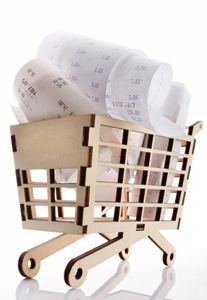In the business world, who hasn’t heard that “cash is king?” Someone (no one really knows who) coined the phrase a long time ago in the late ’80s. The phrase stuck, and it is now ingrained in our financial vocabulary.
This pronouncement emphasizes the paramount importance of having more cash coming into your business than the amount of cash flowing out of it. Cash is arguably just as important (if not more important) than sales and profits.
That’s not to say that sales and profits aren’t important. They are. But here’s my point: Companies usually go out of business not because they’re unprofitable, but rather because they can’t pay their bills. Having record-breaking sales at healthy profit margins is laudable, but you must convert your receivables into cold, hard cash.
While it may seem that I’m stating the obvious, it can’t be all that obvious. The reality is that negative cash flow is a predicament that nearly half of all small businesses face.
The Importance of a Cash Flow Statement
Are you getting a monthly cash flow statement from your accountant? If not, it’s probably a worthwhile expenditure.
The purpose of the cash flow statement is to track how much cash is added to your coffers and how much is subtracted. It also provides you with a picture of where your money is coming from, as well as how your money is being spent. If you have any investors backing you, this will certainly interest them.
Getting a monthly cash flow statement is your early warning system, which can alert you to those manageable minor problems before they grow into major insurmountable problems. Many shops get into financial trouble because the owner or manager isn’t tracking their cash position.
Cash flow statements can be structured in a number of different formats. Some of these formats can be difficult to understand.
Regardless of the format of the report, it should present some basic information. As a starting point, the cash flow statement should provide with your cash on hand at the beginning of each month.
This is your starting point. Added to this are your cash receipts—which consist of cash sales, collections from accounts receivables, deposits (on any jobs that you are starting), and loans, as well as any additional money that you might add to your business.
Subtracted from this sum is cash paid out—which consist of any purchases of raw materials, gross wages, payroll expenses, advertising expenses, etc. The result is the total cash available.
Improving Your Cash Flow
Monitoring your shop’s cash flow—whether you do it on a monthly basis or on some other schedule—will help you adjust your business practices, so you can meet your immediate financial obligations. It will also help you determine your upcoming needs for cash or credit and anticipate any potential problems.
If the money flowing out of your business exceeds the amount coming in, the fiscal health of your business stands on a precarious footing.
Here are a few suggestions to help improve your shop’s cash flow:
- Require that a customer put down a 50 percent deposit on any project. This is one of the best solutions for improving your cash flow, as well as one of the oldest practices in the sign industry. This can offset your purchases of raw materials and labor costs. Payment in full of the balance upon completion of the job can eliminate any collection problems.
- Encourage cash payments or credit card payments. But whenever customers pay by check, make a quick beeline to the bank and deposit them immediately.
- If you extend terms to customers, provide discounts for payments on balances due when customers pay within thirty days. That way you will decrease the time between the sale and the payment.
- Develop an aging report categorizing the aging of your accounts receivable. In a spreadsheet, list past “due balances” in columns for “1 to 30 Days,” “31 to 60 Days,” and “61 to 90 Days.” Assign the responsibility for the aging report to one of your employees, who can make the necessary collection calls.
Many businesses get into hot water when their expenditures increase faster than their sales. Maintain a tight control on any discretionary expenses.

Obviously raw materials ordered into a job are essential. But many other purchases are often unnecessary. Formalized purchasing practices within your shop can help reign in frivolous or wasteful spending.
- Don’t tie your cash up in excessive inventory. Sign shops don’t need a huge stockpile of raw materials to operate efficiently. Keep your stock of materials at a bare bones minimum.
- Periodically review your inventory with an eye for reducing it. As best, you can get in the practice of ordering into the job. Recognize that the value that your sign supply distributor provides is to supply you with the materials that you need, when you need them.
- Preserve your relationships and good standing with your sign supply distributors by paying them within the terms of sale. That way, when you are in a jam and need additional time to pay your bills, your distributors will be more likely to grant you an extension.
- Wait until the deadline to make your payments. While I recommend paying your distributor in a timely manner, that does not mean that you need to pay the bill before it’s due. Waiting until the deadline will improve your available cash.
Until you build up your cash reserves, your shop will likely be in a vulnerable financial position. If your business is relatively young, you may need to take out additional loans.
Just be aware that your interest rate will likely be less than desirable. If the rate is unpalatable, then you may resort to infusing your business with additional cash from your personal bank account.
Final Thoughts on Extending Credit
In the excitement of closing a big deal, it’s very easy for a sales person to extend credit, without giving the decision much thought.
That big deal can result in a big mistake. “Making the sale isn’t always the best thing for your business if you don’t get paid,” says Tim Reimer, controller for Nekoosa Holdings, Inc. “Try and think of the ‘return on investment’ for every decision that you make which involves cash.”
Reimer explains that if you extend a customer a $10,000 credit line when your profit margin is 15 percent, you’re making a $10,000 investment in hopes of making $1,500 in 30 days. “If you don’t get paid or get paid late, you’re out of not only the profits but also the materials and expenses needed to make the sale,” he says. “Understand the risks and ensure that your return on investment is within your expectations.”
Any time that you extend credit, the follow-up with that customer is crucial. Send statements and communicate the importance of timely payments with your customers.
“In many cases, customers will test your responsiveness to late payments to see how long they can stretch things out,” says Reimer. “Keep your customers current. Receivables at the 90-day ‘past due’ date only typically have a 60 to 65 percent chance of collection, which rapidly decreases as time advances.”
By Jim Hingst.











